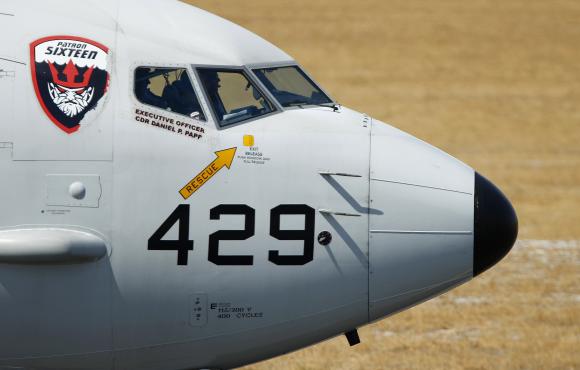(Reuters) – An international air and sea taskforce hunting for the wreckage of Malaysia Airlines Flight MH370 was re-directed on Friday to an area 1,100 km (685 miles) north of where they have been searching for more than a week, after Australian authorities received new radar information from Malaysia.

The dramatic shift in the search area, moving it further than the distance between London and Berlin, followed analysis of radar data that showed the missing plane had travelled faster, and so would have run out of fuel quicker, than previously thought.
The new search area is larger, but closer to the Australian west coast city of Perth, allowing aircraft to spend longer on site by shortening travel times. It is also vastly more favorable in terms of the weather as it is out of the deep sea region known as the Roaring 40s for its huge seas and frequent storm-force winds.
I’m not sure that we’ll get perfect weather out there, but it’s likely to be better more often than what we’ve seen in the past, John Young, general manager of the emergency response division of Australian Maritime Safety Authority (AMSA), told reporters, adding the previous search site was being abandoned.
We have moved on from those search areas to the newest credible lead, he said.
For more than a week, ships and surveillance planes have been scouring seas 2,500 km (1,550 miles) southwest of Perth, where satellite images had suggested there could be debris from Flight MH370, which went missing on March 8 with 239 people aboard.
Ten aircraft searching on Friday were immediately re-directed to the new area of 319,000 sq km (123,000 sq miles), roughly the size of Poland, around 1,850 km (1,150 miles) west of Perth. The Australian Geospatial-Intelligence Organisation was also redirecting satellites there, AMSA said.
A flotilla of Australian and Chinese ships would take longer to shift north, however, with the Australian naval ship the HMAS Success not due to arrive until Saturday morning.
The shift was based on analysis of radar data between the South China Sea and the Strait of Malacca, the Australian Transport Safety Bureau (ATSB) said.
At that time, the Boeing 777 was making a radical diversion west from its course from Kuala Lumpur to Beijing.
ATSB Chief Commissioner Martin Dolan said radar and satellite polling data had been combined with information about the likely performance of the aircraft, speed and fuel consumption in particular, to arrive at the best assessment of the area in which the aircraft was likely to have entered the water.
An international investigative team continued to analyze the data, Dolan said, which could result in further refinement of the potential flight path of MH370.
SHIFTING SEARCHES
The latest twist underscores the perplexing and frustrating hunt for evidence in the near three-week search. It comes less than a day after the latest reports of sightings of possible wreckage, captured by Thai and Japanese satellites in roughly the same frigid expanse of sea as earlier images reported by France, Australia and China.
Satellite images had shown suspected debris, including pieces as large as 24 meters (70 ft), within the original search area in the southern Indian Ocean.
Potential debris has also been seen from search aircraft, but none has been picked up or confirmed as the wreckage of Flight MH370, which disappeared from civilian radar screens less than an hour after taking off.
Officials believe someone on board may have shut off the plane’s communications systems before flying it thousands of miles off course, where it crashed into the ocean in one of the most isolated and forbidding regions on the planet.
Theories range from a hijacking to sabotage or a possible suicide by one of the pilots, but investigators have not ruled out technical problems.
David Brewster, a visiting fellow at the Strategic and Defence Studies Centre at the Australian National University, said it was surprising that the new data analysis was just coming to light.
The Malaysians have never really had to handle a search and rescue operation of this nature before so it is maybe complicated by lack of experience, Brewster said.
There is no doubt they haven’t got their systems working smoothly in terms of sharing within Malaysian organizations or with neighboring countries.
REINFORCEMENTS
The U.S. Navy said on Friday it was sending a second P8-Poseidon, its most advanced maritime surveillance aircraft, to help in the search.
It’s critical to continue searching for debris so we can reverse-forecast the wind, current and sea state since March 8 to recreate the position where MH370 possibly went into the water, said Commander Tom Moneymaker, a U.S. 7th Fleet oceanographer.
The United States has also sent a device that can be towed behind a ship to pick up faint pings from the plane’s black box voice and data recorders, but time is running out.
We’ve got to get this initial position right prior to deploying the Towed Pinger Locator since the MH370’s black box has a limited battery life and we can’t afford to lose time searching in the wrong area, Moneymaker said.
The prolonged and so far fruitless search and investigation have taken a toll, with dozens of distraught relatives of 150 Chinese passengers clashing with police and accusing Malaysia of delays and deception.
Chinese insurance companies have started paying compensation to the families of passengers, some of the firms and state media said.
(Additional reporting by Suilee Wee in Beijing, Niluksi Koswanage in Kuala Lumpur, Stanley White in Tokyo, Amy Sawitta Lefevre in Bangkok and Lincoln Feast in Sydney; Editing by Dean Yates and Alex Richardson)





